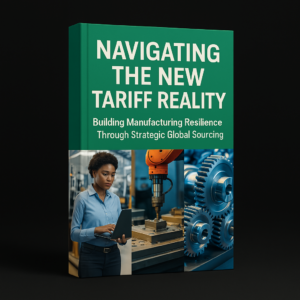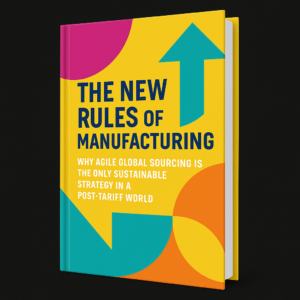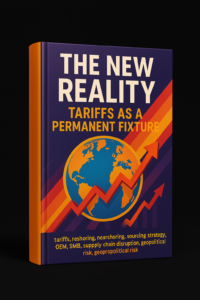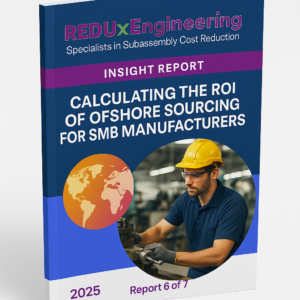
Global supply chains are navigating a minefield of risks in 2025. Trade policies are in flux, with tariffs being used as economic weapons; geopolitical tensions threaten stability in key manufacturing regions; and unforeseen events (from pandemics to wars) can disrupt production and logistics. For manufacturing companies, the question isn’t if another disruption will come – it’s when, and whether they’ll be prepared. This report outlines how businesses can build resilient supply chains through diversification and strategic planning. It covers recent developments (tariffs, trade agreements, geopolitical risks) and provides a roadmap to mitigate these risks by spreading sourcing across multiple regions and partners.
Tariffs and Trade Turbulence:
The trade environment has become increasingly protectionist. In early 2025, the U.S. imposed a sweeping 10% tariff on virtually all imports, with higher rates on countries deemed unfair traders, pushing tariffs as high as 30–54% for some nations. Specific sectors saw dramatic moves – e.g., a new 25% tariff on imported automobiles rattled the automotive supply chain. These moves often provoke retaliation: Canada and Mexico, for instance, threatened counter-tariffs on U.S. goods when faced with a blanket tariff threat and China countered with an immediate 34% on US goods. The whipsaw of tariff policy (which can change with administrations or negotiations) means companies can’t assume today’s rules will hold. A part sourced cheaply from Country A might become expensive overnight due to a policy change.
Geopolitical and Other Risks:
Beyond tariffs, geopolitical tensions pose risks. The U.S.–China strategic rivalry has led to export controls (e.g., on semiconductor tech) and could potentially lead to sanctions or broader trade decoupling. There are also regional stability issues – for example, the war in Eastern Europe or unrest in the Middle East can affect energy prices and shipping routes (the Red Sea Houthi militia attacks in late 2024 forced cargo ships to reroute, adding transit time). Natural disasters (typhoons, earthquakes) tend to be region-specific and can knock out production in an area with little warning. Over-reliance on any single country or region thus concentrates risk. As the NIST 2025 report suggests, while reshoring is a trend, it’s critical to maintain the ability to react to global developments and not become too insular or singly dependent.
The Case for Diversification:
Diversification in supply chain means sourcing from multiple countries or regions, and often maintaining a blend of domestic and offshore sources. The goal is to ensure that a disruption in one place doesn’t halt your operations. Key benefits include:
- Tariff Arbitrage: With a diversified footprint, you can route production to the most cost-favourable location. For instance, if the U.S. slaps a tariff on China, having capacity in, say, Vietnam or India means you can shift orders there and avoid tariff costs. This was seen in the electronics industry when earlier U.S. tariffs hit China – many firms moved production to Vietnam or Taiwan to dodge 25% duties. In our practice, clients using our REDUxTARIFFS China+1 program locked in alternative suppliers in tariff-free ASEAN countries, saving them 15–25% in costs that would have otherwise been tariffs.
- Resilience to Disruption: When COVID-19 shut down China in early 2020, companies that had secondary suppliers in other countries (or inventory buffers) fared much better. Diversification can mean dual-sourcing critical components from two different countries. If one country faces a lockdown or logistics shutdown, the other can often still supply. It also means balancing some production domestically vs. abroad – domestic manufacturing can be a fallback if international transport is disrupted, while offshore manufacturing is a fallback if domestic capacity or infrastructure is impacted.
- Market Access and Avoiding Retaliation: This is a less obvious benefit – if you sell globally, producing in multiple regions can help bypass trade barriers. For example, a U.S. manufacturer that exports to the EU could mitigate EU tariffs on American goods by producing that portion of product in Mexico or Asia and shipping directly. As noted in REDUx’s white paper, “drop-shipping from offshore to international markets eliminates exposure to reciprocal tariffs”. In the scenario where Canada/EU put tariffs on “Made in USA” goods in retaliation, having a non-US production source keeps your goods competitive in those markets.
Implementing a Diversification Strategy:
- Risk Mapping: Start by mapping your supply chain and identifying single points of failure. Which components come 100% from one country? What percentage of your spend is in China vs. elsewhere? Also, consider logistics – reliance on a single port or shipping lane can be a risk. Prioritize which risks are most damaging (e.g., sole-sourced custom parts, or heavy concentration in a potential tariff target country).
- Evaluate Alternative Sourcing Hubs: Depending on your industry, certain regions will be attractive alternatives:
- Mexico & Latin America: Benefiting from proximity to the U.S. and USMCA trade agreement (no tariffs within North America for qualifying goods). Ideal for heavy or bulky items (lower shipping cost) and products where being in a similar time zone aids collaboration. Mexico, for instance, has become a major supplier for automotive, appliances, and electronics assembly for U.S. companies.
- Southeast Asia: Vietnam, Malaysia, Thailand, Indonesia – these have been the big winners of China+1 strategies. Vietnam offers a skilled workforce and has grown electronics and apparel manufacturing. Malaysia and Thailand have strong electronics and automotive part sectors. These countries often have favourable trade terms with various markets and lower labor costs.
- India: An emerging manufacturing hub with large labor availability and improving infrastructure, good for everything from chemicals to heavy equipment components. India isn’t without challenges (bureaucracy, variable quality in smaller firms) but is a key part of many diversification plans, especially as it’s less entwined in U.S.-China tensions.
- Eastern Europe: For European market-focused companies, countries like Poland, Czech Republic, and Romania offer manufacturing capability within the EU or friendly to the EU, reducing dependency on Asia.
- Maintain Some China (wisely): China still has unparalleled capacity and supplier ecosystems. Rather than a full exit, many firms opt to keep China for what it does best (high volume, stable production of mature products) but develop secondary sources elsewhere for flexibility.
- Leverage Free Trade Agreements: Be mindful of FTAs and regional trade blocs. For example, sourcing from countries that qualify for Generalized System of Preferences (GSP) or specific FTAs can lower import duties. The Regional Comprehensive Economic Partnership (RCEP) in Asia can simplify sourcing within Asia. Aligning your supply chain to take advantage of these can save costs and reduce tariff impact.
- Partner with Experts on the Ground: Diversifying globally can be daunting, especially if your team hasn’t sourced from, say, Vietnam or Mexico before. This is where partnering with a service like REDUx Engineering (or similar global sourcing firms) adds value. These partners have established supplier networks across countries and can quickly recommend and vet reliable suppliers in each region, shortening the learning curve. They also handle the legwork of audits, compliance checks, and logistics, ensuring quality remains high.
- Build Flexibility into Contracts: When engaging new suppliers, try to maintain flexibility – e.g., do not commit 100% volume long-term to any single new supplier. Perhaps allocate a portion of volume to alternative suppliers and include clauses that allow you to adjust volumes. This way, if tariffs shift or a new risk emerges, you can re-balance your sourcing more easily. It may slightly reduce economies of scale at one supplier, but the trade-off is agility.
- Monitor Early Warning Indicators: Set up a process to monitor global news for potential disruptions. Many companies create a risk dashboard – tracking things like commodity price trends, shipping indexes, political risk ratings. For instance, if tensions rise in a country where you have a key supplier, you might preemptively boost inventory or shift some orders elsewhere. Being proactive is part of a resilience mindset.
Case Study – Multi-Country Sourcing Success:
An appliances Manufacturing company sourced 80% of its components from China in 2022. Concerned about tariffs and overdependence, they executed a diversification plan by 2025: motors from Mexico, electronic controls from Malaysia, plastics from China (kept in China due to high tooling investment there, but with a backup in Vietnam identified). When the 2025 tariffs hit, Omega was largely unscathed – motors from Mexico were exempt (USMCA), controls from Malaysia faced only the 10% base tariff which was manageable, and for plastics, they negotiated a partial exemption due to in-country assembly. Additionally, when port delays struck Long Beach, they flexed by routing Malaysian shipments to the Port of Houston which handled Gulf routes from Mexico. Their CFO noted that while their blended cost of materials went down ~15%, the bigger win was peace of mind: “We stopped worrying that one political tweet or one port strike could shut us down.” This client’s story underscores how planning and diversification directly translate to risk reduction.
Conclusion:
In today’s volatile global landscape, supply chain diversification is not just a cost strategy – it’s a survival strategy. Companies that develop a flexible, multi-node supply chain can weather tariff storms, navigate geopolitical tensions, and adapt to disruptions far better than those with a monolithic network. Yes, diversification requires effort – qualifying new suppliers, perhaps juggling more logistics lanes – but the payoff is a robust supply chain that keeps your business running smoothly when others might stumble. By following a resilience roadmap that includes global risk awareness, strategic sourcing shifts, and expert partnerships, manufacturers can turn uncertainty into a competitive advantage. In short, the best way to predict the future is to prepare for it: build a supply chain that’s ready for anything.
Making it Safe, Flexible and Successful:
REDUxEngineering can be your “Managed Offshore Sourcing” department, providing SMB manufacturers the on-demand specialized expertise, pre-vetted CM partners. multiple international destinations, language skills, long-term regional relationships and on-site QA staff needed to safely, efficiently, and quickly tap into the savings that diversified global sourcing has delivered to multi-nationals for decades. Hop on our calendar for a 20 minute briefing: https://app.apollo.io/#/meet/david_orton_b36 , or email us with times that work for you: [email protected].
Sources:
- EFulfillment Service – Tariff overview (Apr 2025).
- LinkedIn – Redux Engineering Tariff Navigation Series, Part 5 (2025).
- BLS Strategies – Tariffs May Make 2025 a Tipping Point (Feb 2025).
- Reuters – Middle East unrest affects shipping (Dec 2024).
- REDUx Engineering – White Paper (2025) on global sourcing benefits.
- REDUx Engineering – REDUxTARIFFS Program info (2025).
- NIST – “What’s Coming for US Manufacturing in 2025” (2023).
- Composite Case (Omega Appliances) – based on client diversification outcomes (2025).






